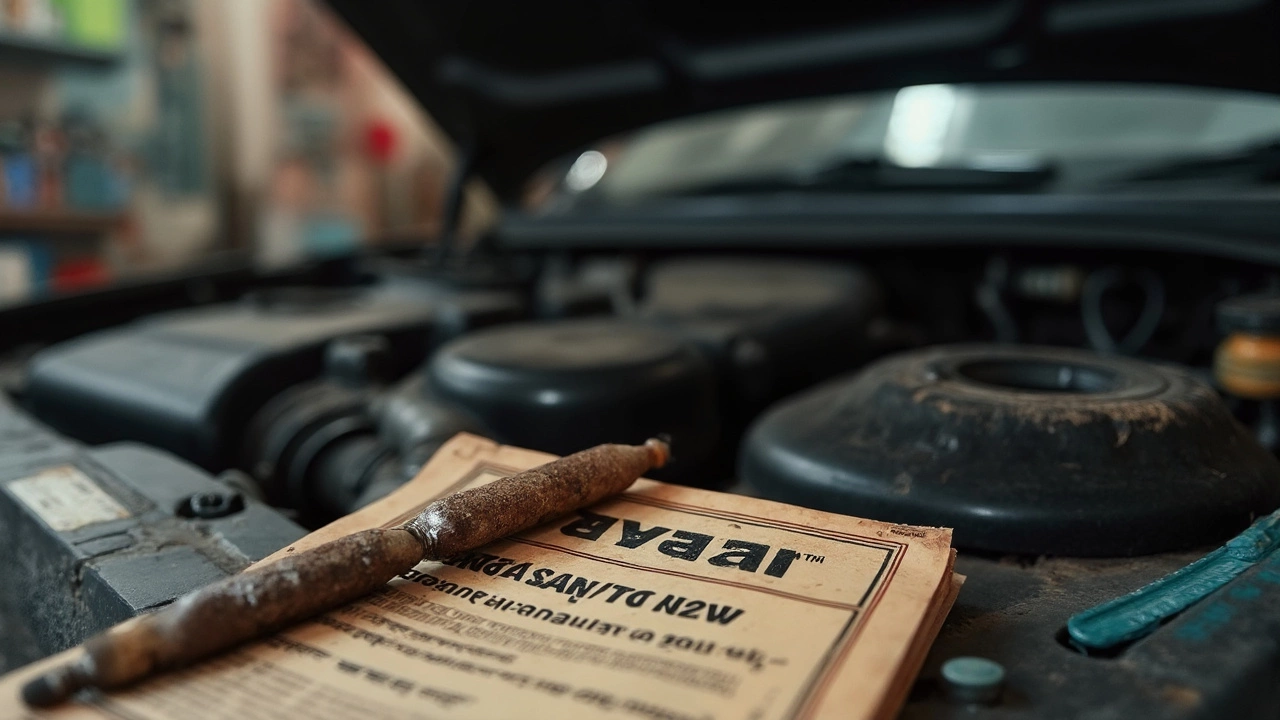 Jun, 3 2025
Jun, 3 2025
Ever see that oil light pop up and wonder just how much time you really have before you're stuck on the side of the road? You're not alone—everyone thinks about pushing it, especially when you're miles from the nearest gas station or in the middle of a hectic day.
Running low on engine oil is a bigger deal than it sounds. It’s not just another warning light and it won’t just “go away” with good luck. Oil isn’t just there for smooth running—it keeps thousands of metal parts from grinding together and generating brutal heat.
Before you guess how far you can make it with that yellow warning glowing, it's worth understanding what’s going on inside your engine. A little bit of info here can save you thousands in repair bills—not to mention the headache of being stranded.
- What Low Oil Really Means
- How Long Can You Actually Drive?
- What Happens To Your Engine
- Warning Signs You Should Never Ignore
- Smart Moves If You Get Stuck With Low Oil
What Low Oil Really Means
Low oil doesn’t just mean you’re a little short on fluid—it’s a red flag telling you your engine’s lifeline is running out. Your car needs oil to keep moving parts slick and cool, and without enough of it, those parts start scraping together. This can turn a simple drive into a pricey disaster.
Modern cars have sensors that kick on the warning light when levels drop below the safe minimum. For many cars, that light comes on when there’s usually less than a quart of oil left. Even a “low” mark on the dipstick means there’s still some oil in the engine, but you’re skating close to the danger zone.
Oil has a few key jobs:
- It cuts friction between engine parts.
- It helps keep the engine cool.
- It collects dirt and tiny metal bits so they don’t cause wear.
- It helps prevent rust inside important parts.
Without enough oil, even a brand-new engine can start making weird noises—think knocking or ticking. Worst case, you might see costly engine damage in just a few miles if the oil is too low or gone.
Here’s a quick look at what happens as oil drops off:
| Oil Level | What’s Happening |
|---|---|
| Full | Engine protected, cool, and smooth. |
| One Quart Low | Increased heat, slight wear, still safe for short trips. |
| Warning Light On (Very Low) | Risk of overheating, loud noises, engine damage possible. |
| No Oil | Severe damage in minutes—engine can seize up and fail. |
If you see that low oil light, don’t brush it off. Fixing an oil leak or topping up can cost under $50, but ignoring it can cost thousands in repairs. The low oil warning isn’t just a suggestion—it’s your engine asking for help.
How Long Can You Actually Drive?
This is the question everyone wants a straight answer to, but the honest truth: there’s no magic number for all cars. It all depends on how low your oil really is, what kind of engine you have, and how hot that engine gets. But let’s cut through the noise and get into the details you need.
First things first—driving with low oil isn’t the same as driving with no oil. If your dipstick still shows some oil, but it’s at or just above the minimum line, your car might limp along for 50 to 100 miles, maybe a little more, before serious problems kick in. But if the oil light just came on or you hear ticking or knocking, you could have even less time. Some engines seize up in just a few minutes once the oil runs out completely.
Check out the ballpark numbers from real-world cases and what automakers say:
| Condition | How Far You Can Drive (Approx.) |
|---|---|
| Oil just at minimum | 50-100 miles (risky) |
| Oil light just came on | 5-20 miles (emergency only) |
| No oil showing on dipstick | 1-5 miles (expect engine damage) |
These numbers aren’t promises—they’re worst-case estimates that could end with your engine locking up for good. Even if you do make it, wear and tear jumps up fast. One AAA study found engines run at least 30% hotter with low oil levels. Not cool, unless you enjoy surprise breakdowns and big repair bills.
- If that oil warning comes on, slow down and aim for the nearest safe stop. Don’t try to "just get home."
- Never push it on a long drive—you might make it today, but each mile damages your engine more.
- Modern engines with turbochargers overheat even faster if they get low on oil—sometimes twice as quick as non-turbo models.
If you’re sitting there asking, “But what’s the real risk?” Here it is: low oil is one of the quickest ways to wreck an engine, and you rarely get a second warning. Play it safe—top off or change your oil as soon as that light flickers on. Your wallet will thank you later.

What Happens To Your Engine
If you keep driving with low oil, things get dicey fast. Oil isn’t just for keeping your engine clean or making things run smooth—it’s the only thing protecting all those moving metal parts from destroying each other. Without the right amount, friction and heat skyrocket.
With less oil, your engine temperature climbs and parts like pistons, bearings, and cams start rubbing directly against each other. This rubbing can cause serious wear in minutes, not hours. Ever heard of a "seized engine"? That’s when things get so hot and dry they actually fuse together or lock up completely. Once that happens, a simple oil top-up won’t fix it. You’re usually looking at a full rebuild or a brand new engine.
- Oil also helps keep dirt and metal shavings from building up. Low oil means debris can grind away at delicate pieces, making wear even worse.
- Most engines these days include sensors, but there’s often a delay from the time your low oil light comes on to when internal damage actually starts. Sometimes it's only a few minutes.
- If your car suddenly makes clattering, knocking, or grinding sounds after running low, stop—these are early warning sounds that things are about to get expensive.
Bottom line, oil is your engine’s life support. Dropping even a quart below the recommended level can lead to a chain reaction of small failures that eventually add up to a full-blown mess. Damage doesn’t always show right away, but driving with low oil is like running a marathon while dehydrated—you might keep going for a while, but it’s only a matter of time before something gives.
Warning Signs You Should Never Ignore
Ignoring the signals your car gives you when oil is low is a surefire way to trash your engine way faster than you think. Here are the most obvious and urgent warning signs that mean you need to pull over or add oil—now:
- Oil warning light on the dash: If you see this, don’t put it off. This light means your oil pressure isn’t at a safe level. Even if the car is still running fine, low oil could stop it cold with only a few more miles.
- Knocking or ticking noises: When you start to hear weird tapping or metal-on-metal sounds, it means your engine parts aren’t getting enough oil. This is a critical alert and can turn into engine failure super fast.
- Burning oil smell: If you smell burning oil (not just a whiff outside the car, but inside too), it means oil could be leaking onto hot parts of your engine.
- Smoke from the exhaust: Blue or grey smoke means your car is burning oil, not just gasoline. This wastes oil fast and makes the low oil problem worse.
- Engine running hot: If your temperature gauge starts creeping up or hits the red zone, low oil might be the cause. Oil cools moving parts, so less oil often means more heat.
Here’s a quick look at how common these warning signs are and what they can lead to if ignored:
| Warning Sign | Percent of Drivers Who Reported Issue* | Risk if Ignored |
|---|---|---|
| Oil Warning Light | 56% | Engine seizure |
| Knocking/Ticking Noises | 35% | Permanent engine damage |
| Burning Oil Smell | 22% | Oil leaking, fire risk |
| Smoke from Exhaust | 18% | Catalytic converter failure |
| Engine Running Hot | 28% | Overheating, blown gasket |
*Data: AAA Car Care (2024 customer survey)
If you spot even one of these signs, get your oil checked as soon as you can. Your wallet will thank you. That low oil warning isn’t something to joke about—small problems add up way too quick when you’re talking about vital engine parts.

Smart Moves If You Get Stuck With Low Oil
Alright, so your oil warning light is on and you’re low on oil. Don’t just hope for the best—here’s what you need to do right now to avoid turning a bad situation into a disaster.
- Stop as soon as you safely can. Pull over in a safe spot, turn off the engine, and let it cool for a few minutes. Driving even a short distance with low oil can cook the engine.
- Check your oil level with the dipstick if you have one. Some modern cars hide the dipstick, but most older models have one right under the hood. If it’s below the minimum line, don’t keep driving.
- If you’ve got spare oil in your trunk, even a partial quart is better than nothing. Add oil—any matching SAE grade will help in a pinch, even if it’s not your exact brand or viscosity. This is about survival, not perfection.
- No spare oil? Call for help or walk to the nearest store. It’s way smarter to spend twenty bucks on oil now than thousands on an engine later.
- If you absolutely must drive (like you’re blocking traffic and can’t stay there), keep it slow and gentle. Avoid speeding or heavy acceleration, and never let the engine overheat. Treat it like there are eggs under the gas pedal.
Don’t forget, ignoring low oil can kill your car. Studies from AAA show that engines running with low or no oil seize up in as little as 30 seconds in some cases once the warning light is on.
If you’re stuck somewhere remote, now’s the time to think outside the box. If a friendly driver stops, ask if they can bring you the right oil from a gas station. You can even use oil made for trucks in an emergency, just to get your car to safety.
The takeaway: when your low oil light is on, minimizing engine run time is your top priority. Never roll the dice—your engine won’t forgive you.